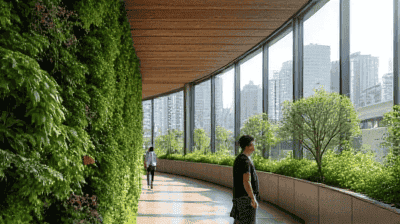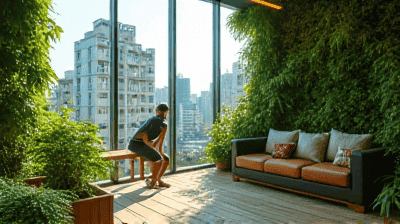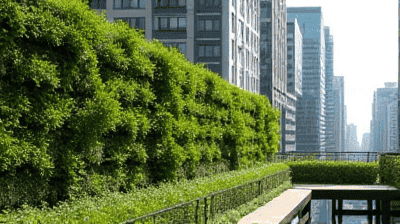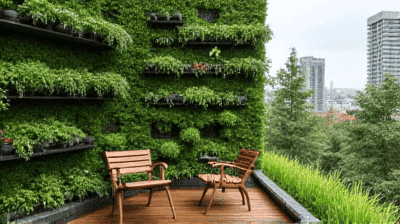
As urban areas become increasingly dense and concrete-heavy, the need for sustainable and restorative design has never been more critical. Biophilic design—an approach that seeks to strengthen the relationship between people and nature—has emerged as a groundbreaking solution to enhance urban living.
Biophilic design is rooted in the idea that humans are inherently connected to nature. This connection can be fostered through design that incorporates natural elements to promote well-being, improve air quality, and create aesthetically pleasing environments. The principles of biophilic design can be categorized into various strategies, including direct and indirect experiences of nature.
Natural Elements: Incorporating plants, water features, and natural materials into urban spaces.
Natural Light: Maximizing daylight through architectural design to enhance mood and productivity.
Spatial Variety: Creating diverse and dynamic spaces that mimic the complexity of natural environments.
Topography and Terrain: Designing landscapes that reflect natural landforms to create inviting and engaging environments.
Green Spaces: Integrating parks, gardens, and green roofs into urban planning to offer residents a respite from city life.
These principles are fundamental to realizing the full potential of living walls and rooftop gardens in urban settings.

Living walls, also known as vertical gardens or green walls, are vertical surfaces that are partially or completely covered with vegetation. These installations can be applied to both interior and exterior walls and can utilize various plant species.
Air Quality Improvement: Living walls filter pollutants from the air, contributing to cleaner indoor and outdoor spaces.
Thermal Regulation: Vegetation helps insulate buildings, reducing energy consumption for heating and cooling.
Noise Reduction: Plants can absorb sound, making urban environments quieter and more pleasant.
Aesthetic Appeal: Living walls add visual interest and beauty to otherwise bland building facades.
Rooftop gardens consist of gardening spaces situated on building roofs, regardless of how much space is available. These gardens can vary from simple green spaces to complex ecosystems.
Stormwater Management: Rooftop gardens absorb rainwater, reducing runoff and mitigating flooding risk.
Biodiversity Promotion: These gardens can serve as habitats for various species, enhancing urban biodiversity.
Food Production: Rooftop gardens offer opportunities for urban agriculture, allowing residents to grow their own food.
Social Spaces: They can function as community gathering spots, improving social interaction and community cohesion.
As cities rapidly expand, the need for innovative environmental management solutions becomes critical. Biophilic design, particularly through living walls and rooftop gardens, presents a harmonious way to blend nature into urban environments.
Research consistently shows that exposure to nature positively impacts mental health. Urban spaces often lack sufficient greenery, leading to increased stress, anxiety, and depression among residents. Integrating biophilic design elements, such as living walls and rooftop gardens, can cultivate a sense of connection to nature, reduce stress, and enhance overall well-being.
Psychological Benefits: Being around greenery can boost mood, reduce feelings of anxiety, and promote mental calmness.
Social Interaction: Gardens provide social spaces that encourage interaction and community bonding, which are essential for mental health.
Urban areas are increasingly vulnerable to the challenges posed by climate change, including extreme weather events and rising temperatures. Living walls and rooftop gardens can play a pivotal role in enhancing urban resilience:
Heat Island Effect Mitigation: Vegetation cools the surrounding environment and reduces the urban heat island effect, which is particularly important in cities.
Flood Mitigation: By absorbing rainwater, rooftop gardens help attenuate stormwater runoff and reduce the risk of flooding in urban areas.
Carbon Sequestration: Plants capture carbon dioxide, contributing to lower overall emissions in cities.
One of the most significant operational costs for urban buildings is energy consumption for heating and cooling. Living walls and rooftop gardens can enhance energy efficiency, providing substantial savings over time:
Insulation Properties: Green walls and roofs add insulation, leading to reduced energy requirements for temperature control.
Cooling Benefits: Vegetation cools the surrounding air, decreasing the need for air conditioning during hot summer months.
Urban areas are commonly plagued by air pollution from vehicles, industry, and other sources. Living walls and rooftop gardens can ameliorate air quality through:
Sediment and Particulate Filtration: Plants capture particulates, dust, and other pollutants, leading to cleaner air.
Oxygen Production: Greenery produces oxygen through photosynthesis, improving the overall air quality for urban residents.
Urban environments often suffer from habitat loss, leading to a decline in local flora and fauna. Biophilic design through living walls and rooftop gardens creates new habitats that support urban biodiversity:
Pollinator Habitats: Including flowering plants can support bees, butterflies, and other essential pollinators in urban ecosystems.
Wildlife Corridors: Green infrastructures, such as living walls, can act as green corridors that facilitate wildlife movement within the city.

To maximize the benefits of living walls and rooftop gardens, proper planning and execution are essential. Here are some best practices to consider:
Before installing a living wall or rooftop garden, it is crucial to assess the site characteristics:
Structural Integrity: Ensure that the building can support the additional weight of a living wall or garden.
Sunlight Exposure: Analyze the available sunlight throughout the day to determine suitable plant species.
Accessibility: Ensure that the roof or wall can be easily accessed for maintenance and upkeep.
Choosing the right plants is key to a thriving living wall or rooftop garden. Consider the following:
Local Climate: Select species that are well suited to the local climate and can thrive in the specific environment.
Maintenance Requirements: Choose low-maintenance species if the garden or wall will not have regular care.
Diversity: Incorporate a mix of plants to enhance biodiversity and visual appeal.
Effective design is vital for maximizing the benefits of living walls and rooftop gardens:
Irrigation Systems: Implement efficient watering systems to maintain plant health while minimizing water waste.
Soil Selection: Use lightweight soil mixes that provide adequate drainage and nutrition for the plants.
Layout: Arrange plants in a way that creates visual interest while ensuring proper spacing for growth.
Sustaining living walls and rooftop gardens requires ongoing maintenance:
Regular Inspections: Periodically check for signs of plant stress, pests, or diseases.
Water Management: Monitor irrigation systems to ensure plants receive the necessary water without overwatering.
Fertilization: Provide appropriate nutrition to plants to promote healthy growth and flowering.
To further illustrate the advantages of living walls and rooftop gardens, let’s examine several successful projects around the world.
The Bosco Verticale, or "Vertical Forest," consists of two residential towers adorned with over 9,000 trees and 20,000 plants. This project serves various purposes, including providing habitat for urban wildlife, improving air quality, and offering residents a unique connection to nature.
Biodiversity: The towers host diverse plant species, contributing to urban biodiversity and providing habitats for birds and insects.
Cooling Benefits: Vegetation helps to cool the surrounding air, significantly reducing energy consumption for climate control.
One Central Park is a mixed-use development featuring iconic living walls designed by renowned architect Frank Gehry. Each building is covered in vertical gardens that transform the urban landscape.
Community Spaces: The rooftop garden features communal areas for residents, enhancing social interaction and community engagement.
Sustainable Design: The project incorporates energy-efficient technologies and sustainable materials, contributing to its overall environmental effectiveness.
This iconic living wall at the California Academy of Sciences showcases a variety of native plant species, creating a stunning visual display and supporting local biodiversity.
Educational Opportunities: The wall serves as an educational tool, teaching visitors about ecological balance and the importance of biodiversity.
Air Quality Improvement: The living wall plays a crucial role in filtering pollutants and contributing to cleaner air within an urban setting.

Living walls and rooftop gardens exemplify the power of biophilic design in enhancing urban environments. By integrating nature into the built environment, these features promote health and well-being, support climate resilience, improve air quality, and foster biodiversity. As cities continue to grow and face environmental challenges, embracing biophilic design will be crucial in creating sustainable, vibrant, and livable urban spaces.
Incorporating living walls and rooftop gardens into urban planning represents not merely a trend but a transformation—a shift toward a more harmonious coexistence between urban life and nature. By prioritizing these practices, cities can become greener, healthier, and more connected to the natural world.